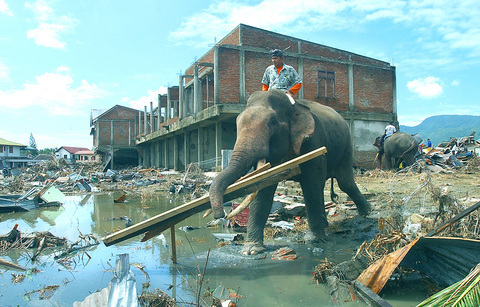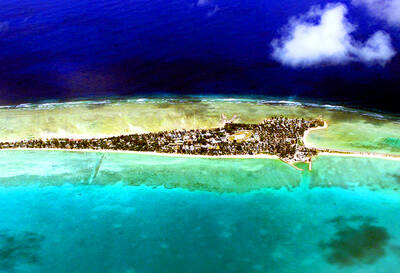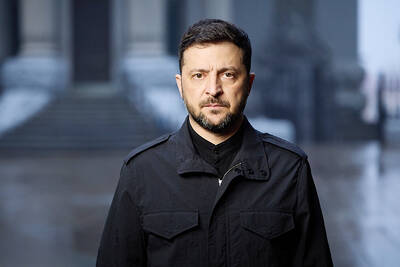In the wake of an ocean wave that horrified an unready world, hundreds of UN conference delegates yesterday got down to the business of finding ways to give man more of an edge in an age-old battle with the worst of nature.
"We must draw and act on every lesson we can," UN Secretary-General Kofi Annan told participants in the World Conference on Disaster Reduction, which opened with a moment of silence for the more than 160,000 people killed in the Dec. 26 earthquake-tsunami that ravaged coasts across south Asia.

PHOTO: AP
"The world looks to this conference to help make communities and nations more resilient in the face of natural disasters," Annan said in his videotaped message.
The first day's agenda for the five-day meeting focused on routes to resilience: by protecting such critical facilities as hospitals and power plants against damage; building earthquake-safe structures, and bolstering communications systems, among others.
The Japanese government announced it would refocus its foreign aid program to put more emphasis on disaster reduction. Prime Minister Junichiro Koizumi, addressing the conference, also said his government would offer tsunami-warning training to countries struck by the powerful, earthquake-spawned wave that sped across the Indian Ocean last month.
"It will be possible to save many lives in future Indian Ocean tsunamis if early warning mechanisms are rapidly developed," he said.
An immediate conference goal is to lay the foundation for an Indian Ocean alert network like the one on guard for tsunamis in the Pacific. The UN Educational, Scientific and Cultural Organization (UNESCO) is presenting a blueprint for a system of deep-water buoys, tide gauges and a regional alert center that would cost US$30 million and go into operation by the middle of next year. Several sessions here will deal with the practicalities of the plan.
"Rarely has a tragedy made a conference so topical and timely as this one," Annan said.
His UN emergency coordinator, Jan Egeland, told reporters he hopes governments and UN agencies will make a "strong commitment" here to establish the Indian Ocean system. He also said he believed that over the next 10 years -- the period covered by this conference's "framework of action" -- all vulnerable populations will be covered by advance warning systems.
It was "heartbreaking," he said, to see almost 3,000 people killed in Haiti by a hurricane last summer, when better-prepared countries, such as Cuba and the US, suffered relatively few casualties.
He told the conference, however, that "technology is not a cure-all."
Beyond the "hardware," Egeland said, children should be educated to the risks of disasters; hospitals, clinics and schools should be viewed as safe havens and built to withstand quakes, cyclones and other disasters; and all disaster-prone countries should adopt "action plans" to deal with the threats.
The conference convened in Kobe 10 years after much of this Japanese city was devastated in an earthquake that killed 6,400 people. Japanese officials this week cited this country's experience with natural disasters as an example for other nations.
"The most important factor in disaster reduction is to learn lessons from past disasters and to take measures in response," Japan's Emperor Akihito said.
His government's minister for disaster management, Yoshitaka Murata, noted that tropical storms were once major killers here.
"In the devastated and vulnerable land after World War II, every major typhoon cost us thousands of lives," he said. "Japan has since reinforced the systems for disaster management and invested in disaster reduction. Today, the number of victims from typhoons has been greatly reduced."

DISASTER: The Bangladesh Meteorological Department recorded a magnitude 5.7 and tremors reached as far as Kolkata, India, more than 300km away from the epicenter A powerful earthquake struck Bangladesh yesterday outside the crowded capital, Dhaka, killing at least five people and injuring about a hundred, the government said. The magnitude 5.5 quake struck at 10:38am near Narsingdi, Bangladesh, about 33km from Dhaka, the US Geological Survey (USGS) said. The earthquake sparked fear and chaos with many in the Muslim-majority nation of 170 million people at home on their day off. AFP reporters in Dhaka said they saw people weeping in the streets while others appeared shocked. Bangladesh Interim Leader Muhammad Yunus expressed his “deep shock and sorrow over the news of casualties in various districts.” At least five people,

It is one of the world’s most famous unsolved codes whose answer could sell for a fortune — but two US friends say they have already found the secret hidden by Kryptos. The S-shaped copper sculpture has baffled cryptography enthusiasts since its 1990 installation on the grounds of the CIA headquarters in Virginia, with three of its four messages deciphered so far. Yet K4, the final passage, has kept codebreakers scratching their heads. Sculptor Jim Sanborn, 80, has been so overwhelmed by guesses that he started charging US$50 for each response. Sanborn in August announced he would auction the 97-character solution to K4

SHOW OF FORCE: The US has held nine multilateral drills near Guam in the past four months, which Australia said was important to deter coercion in the region Five Chinese research vessels, including ships used for space and missile tracking and underwater mapping, were active in the northwest Pacific last month, as the US stepped up military exercises, data compiled by a Guam-based group shows. Rapid militarization in the northern Pacific gets insufficient attention, the Pacific Center for Island Security said, adding that it makes island populations a potential target in any great-power conflict. “If you look at the number of US and bilateral and multilateral exercises, there is a lot of activity,” Leland Bettis, the director of the group that seeks to flag regional security risks, said in an

‘DIGNITY’: The Ukrainian president said that ‘we did not not betray Ukraine then, we will not do so now,’ amid US pressure to give significant concessions to Russia Ukrainian President Volodymyr Zelenskiy on Friday pushed back against a US plan to end the war in Ukraine, while Russian President Vladimir Putin welcomed the proposal that includes many of his hardline demands. With US President Donald Trump giving Ukraine less than a week to sign, Zelenskiy pledged to work to ensure any deal would not “betray” Ukraine’s interests, while acknowledging he risked losing Washington as an ally. Putin said the blueprint could “lay the foundation” for a final peace settlement, but threatened more land seizures if Ukraine walked away from negotiations. Ukraine faces one of the most challenging moments in its history,